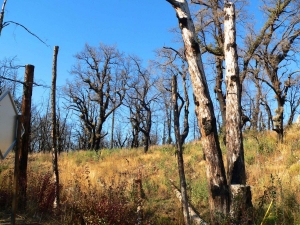Dead, Dying, and Diseased Oaks May Be Infested
 San Diego, CA- August 31, 2009…The gold-spotted oak borer is a newly detected insect pest that affects California black oaks, coast live oaks, and canyon live oaks in southern California. This pest is believed to be responsible for significant tree mortality in San Diego County. Over 17 thousand trees have been killed across 28 thousand acres in and around the communities of Descanso, Guatay and Pine Valley.
San Diego, CA- August 31, 2009…The gold-spotted oak borer is a newly detected insect pest that affects California black oaks, coast live oaks, and canyon live oaks in southern California. This pest is believed to be responsible for significant tree mortality in San Diego County. Over 17 thousand trees have been killed across 28 thousand acres in and around the communities of Descanso, Guatay and Pine Valley.
Federal, state, and local officials are taking action now, while the oak borer infestation still covers only a portion of the county, in hopes of reducing the scope of the insect's spread. Indicators that a tree may be infested include crown thinning, beginning of significant leaf dropping, and die-back of twigs.
A Web site has been created to provide further information about local resources and a map of the infested areas. Instructions on how to send a sample from a tree that may be infested by the oak borer to the County of San Diego Department of Agriculture, Weights and Measures is included. For information, please visit: http://groups.ucanr.org/GSOB/.
Officials have not yet determined a way to stop the spread of the oak borer completely. However, community members are requested to do three things to help limit the spread of the oak borer throughout the county and reduce the chances that more oaks will die on private and public lands:
1. Do not transport oak firewood into or out of campgrounds or parks.
2. Leave oak firewood at home and use local sources of firewood when you camp or have picnics.
3. When you use local oak firewood, leave any unburned wood on-site when you return home.
Stopping the transportation of oak firewood is important because the oak borer typically lays its eggs in bark crevices. The larvae grow to be 18 mm long and 3 mm wide. As they grow and feed, the larvae dig into the tree, creating tunnels--or "galleries"--on the surface of the sapwood. These feeding habits kill sections of a tree and, over a period of a few years, the entire tree itself. As they mature, the oak borers leave the tree by making D-shaped exit holes about 3 mm wide.
The oak borers are compact and bullet-shaped. They can be identified easily by their dull, metallic green color and the three golden spots that are located on each wing.
The following three methods can be used to help reduce potential oak borer populations in dead and/or dying trees. These methods are listed in decreasing order of effectiveness.
1. Chip infested material: Chipping infested oak wood to one-inch pieces is the best method for eliminating oak borer populations.
2. Cover infested wood: If oak firewood cannot be chipped, cover the wood with 6 mm, UV-stabilized, durable plastic tarps beginning in the spring. Tarps should be used until the end of September. Pin or otherwise secure all the edges of the tarp to the ground to prevent beetles from escaping. It is best to tarp oak firewood piles in continual direct sunlight with a southern exposure. Check the tarp periodically to ensure that it does not shred and therefore allow escape routes for the oak borers.
3. Season oak firewood with bark removed in direct sunlight: Scatter oak firewood in areas in direct sunlight, preferably with a southern exposure, for an entire growing season. Cut or split large pieces of wood into smaller pieces to enhance drying. Removing and destroying the bark also can facilitate control of the oak borer. Turn over the firewood monthly to expose all edges to direct sunlight.
For more information and local resources please go to http://groups.ucanr.org/gsob







Recent comments